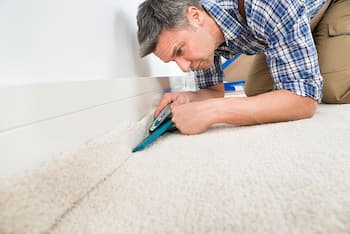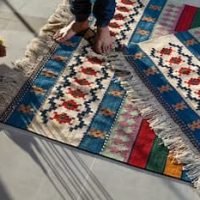At times after you have installed the carpet, you will notice some gaps in between the baseboard and the flooring. We have come up with ways in which you can seal and correct the identified problem with your flooring.
There are plenty of ways how to fill the gap between carpet and baseboard and come up with an outstanding floor. Gaps found between the carpet and the baseboard that thick tend to not fit properly so they have to be trimmed to fit under the baseboard.
This happens if the allowances and measurements are done inaccurately for both the baseboard and the carpet. However, older homes tend to get and grow gap, but thankfully we have managed to identify a way(s) or solutions to fixing these kinds of problems.
- Caulk to fill any gap between the carpet and the baseboard
- Replace or make adjustments to the baseboard
- Make use of expanding foam
- Add some padding in the baseboard
- Add extra molding on the baseboard
Once you find out that there is a gap between the baseboard and the carpet, then read along to find better ways how to fill gap between carpet and baseboard.
What are the ways used to fill the gap between floor and baseboard?
Have a good sight of the gaps between the floor and the baseboard before jumping to a conclusion. You might have plenty of solutions to fix a gap between baseboard and floor but it will all depend on the reason why.
One of the reasons can be, the baseboard is higher or even lower bringing up the issue with the gap. The second reason could be that the carpet is too short or needs a little bit of stretching.
Lastly, the gaps between wood floors could be caused by larger baseboards, molding addition or even shifting of the baseboard. So, you need to check your flooring before settling on a means to fill the gaps between the floor and baseboard.
Apply Caulk to fill the gap
The Caulk process is used immediately after you apply a thin layer of the painter’s tape over the topmost place of your baseboard. Cautiously apply a thin line layer of caulk in the gap between the baseboard and carpet in the space for molding.
Ensure that you do not get the caulking outside the molding or the carpet. In case this happens, you should be prepared for thorough cleaning.
Caulk is tricky when it comes to being removed.
But when you fill the affected floor wall base, then you may not have to repair or clean the place.
Adjust the baseboards or replace them
Baseboards are always installed first before the carpet flooring or lamination. A small gap is left behind.
You can also install the baseboard after layering down the carpet but that will cause future adjustments.
So the solution to this problem is if the baseboards are positioned too low for your carpet to be tucked in or they are too high then you’re excused to leave a huge gap for you to make some movements and adjustments.
In case the baseboards are small or big for your desired carpet then replace those boards, so make sure you protect them.
Using expanding foam
Using your expanding foam, cover up the smaller or tiny gap between the carpet and baseboard. Just like using caulk to fill the gaps, clumsiness is not allowed in this procedure.
Take all your time to seal the gaps with the foam and ensure you don’t spill it into unwanted areas. As usual, be ready in case any accident happens.
Ensure that you use the recommended foam quantity, in order for you to be able to fit in the carpet with a tighter grip. Give the foam some time to dry up, then reduce any excess that’s beyond the baseboards.
Now, tuck in the carpet under to cover the gaps.
Add in some padding in the baseboard
The other method that you can use to cover gaps is by adding padding layers under the baseboards. Once you add the padding to the gap, push the carpet backward and tuck it in.
This will ensure that the baseboard and carpet have a greater fit into the added padding.
However, you should note that this method is mostly used by professionals to fix a large gap between a baseboard.
Add an extra molding on the baseboard
It is totally okay to add or top up the pre-existing mold. These holes can be filled by carefully taking the right measurements for the spaces needed to be filled.
Mold or trim aesthetically by closing all the gaps between the baseboard and carpet. Ensure that the carpet has been fully tucked and stretched out.
After all, this is done, install your second layering of the mold and nail it. This will lock the baseboards and the carpet.
How to fill gaps in a carpet?
With time our carpets tend to buckle up and bunch up at some places due to foot and floor traffic. This is a common thing that happens and at times it exposes the gaps.
Baseboards are meant to be installed before carpeting. This is done to ensure that a small board gap is left underneath the baseboard.
However, some other people prefer installing the carpet up to the corners of the room covering all the tile. In case your carpet is too thick, then you should trim a second layer for a much tighter grip for later installation of the baseboard.
Installing baseboards to the rooms as the last option gives you an allowance to shift or try a larger baseboard to cover. This decreases the chances of having gaps.
In case the gap between the carpet is exposed, it may be rectified by stretching or pulling it out before taking it back to its initial position. If the carpet has been cut short, you can always choose to add some leftovers to the carpet to fill the gap between carpets and baseboards.
Ensure that these patches face the same direction as the initial carpet. You can opt to use the carpet adhesive to fill the gap between the floor.
Conclusion
In case you find a gap between baseboard and carpet, allow yourself to internalize the situation and use some of the methods we have discussed above.
Some of the best methods though are foam to fill the gaps between wood floors and walls and caulk the gap between the baseboard. Or choose to stretch your carpet a bit.
The thickness of your carpet will determine how you will be able to put the carpet in alignment with the baseboards.






